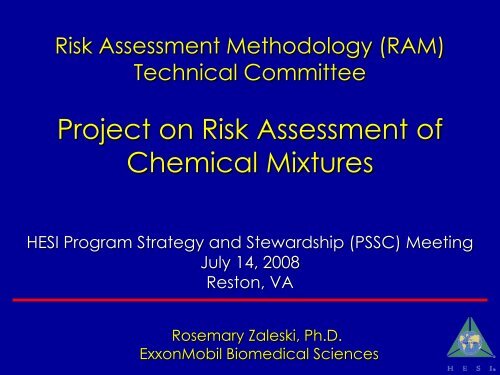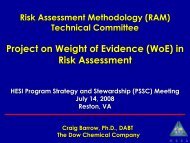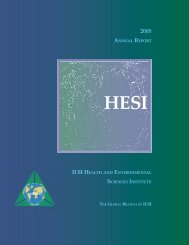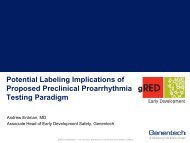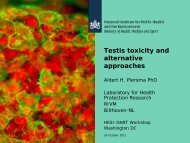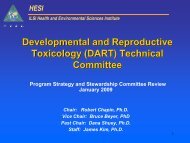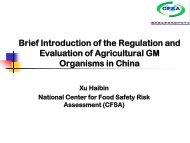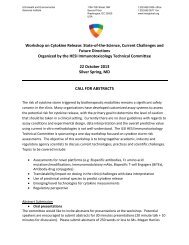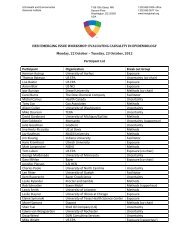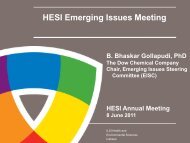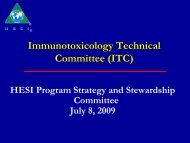Project on Risk Assessment of Chemical Mixtures
Project on Risk Assessment of Chemical Mixtures
Project on Risk Assessment of Chemical Mixtures
Create successful ePaper yourself
Turn your PDF publications into a flip-book with our unique Google optimized e-Paper software.
<strong>Risk</strong> <strong>Assessment</strong> Methodology (RAM)<br />
Technical Committee<br />
<str<strong>on</strong>g>Project</str<strong>on</strong>g> <strong>on</strong> <strong>Risk</strong> <strong>Assessment</strong> <strong>of</strong><br />
<strong>Chemical</strong> <strong>Mixtures</strong><br />
HESI Program Strategy and Stewardship (PSSC) Meeting<br />
July 14, 2008<br />
Rest<strong>on</strong>, VA<br />
Rosemary Zaleski, Ph.D.<br />
Exx<strong>on</strong>Mobil Biomedical Sciences
<strong>Mixtures</strong> <str<strong>on</strong>g>Project</str<strong>on</strong>g> Participati<strong>on</strong><br />
CHAIR<br />
Rosemary Zaleski, Ph.D.<br />
INDUSTRY<br />
Bayer CropScience<br />
The Coca-Cola Company<br />
The Dow <strong>Chemical</strong> Company<br />
Dow Corning<br />
Exx<strong>on</strong>Mobil Biomed. Sciences, Inc.<br />
Pfizer, Inc.<br />
The Procter & Gamble Company<br />
Rohm and Haas Company<br />
Syngenta Ltd.<br />
GVT/ACADEMIA/OTHER<br />
Centers for Disease C<strong>on</strong>trol, ATSDR<br />
Colorado State University<br />
Imperial College L<strong>on</strong>d<strong>on</strong><br />
U.S. Food and Drug Administrati<strong>on</strong><br />
University <strong>of</strong> Guelph<br />
U.S. Envir<strong>on</strong>mental Protecti<strong>on</strong> Agency
<strong>Mixtures</strong> <str<strong>on</strong>g>Project</str<strong>on</strong>g>: History<br />
• Initiated in 2005 as part <strong>of</strong> RAM<br />
• Aims to develop a decisi<strong>on</strong>-framework to advance<br />
and improve mixtures risk assessment methodology<br />
• Current project focused at present <strong>on</strong> the potential<br />
applicati<strong>on</strong> <strong>of</strong> a threshold <strong>of</strong> toxicological c<strong>on</strong>cern<br />
(TTC) approach to mixtures risk assessment as a<br />
critical “decisi<strong>on</strong> point.”
<strong>Mixtures</strong> <str<strong>on</strong>g>Project</str<strong>on</strong>g>: Objective<br />
How to prioritize those envir<strong>on</strong>mental chemical mixtures<br />
that should be subject to in-depth risk assessment and<br />
those that are expected to be <strong>of</strong> lesser c<strong>on</strong>cern<br />
Examine the applicability <strong>of</strong> the Toxicological<br />
Threshold <strong>of</strong> C<strong>on</strong>cern (TTC) c<strong>on</strong>cept to chemical<br />
mixtures as a screening-level, prioritizati<strong>on</strong> approach<br />
– TTC proposes that a de minimis value can be<br />
identified for many chemicals based <strong>on</strong> SAR<br />
– When structural data are available, SAR can be<br />
used to inform TTC
TTC and <strong>Mixtures</strong>: Key Questi<strong>on</strong>s<br />
• How do you combine exposure values for multicomp<strong>on</strong>ent<br />
mixtures where interacti<strong>on</strong>s are<br />
possible<br />
• How do you deal with mixtures that c<strong>on</strong>tain<br />
chemicals in different Cramer classes<br />
• How do you evaluate mixtures where chemical<br />
structures are unknown<br />
• How do you handle mixtures that c<strong>on</strong>tain chemicals<br />
not suitable for TTC (e.g., the Cohort <strong>of</strong> C<strong>on</strong>cern;<br />
aflatoxin, dioxins, etc.)
Low-Level Exposures<br />
• Approaches to mixtures assessment<br />
– Comm<strong>on</strong> MOA: Dose additi<strong>on</strong><br />
– Not a comm<strong>on</strong> MOA: Resp<strong>on</strong>se additi<strong>on</strong><br />
• Synergy is possible <strong>on</strong> rare occasi<strong>on</strong>s<br />
• How do you proceed in the absence <strong>of</strong> data <strong>on</strong><br />
what is present
<str<strong>on</strong>g>Project</str<strong>on</strong>g> Plan and Scope <strong>of</strong> Work<br />
Goal: Develop a framework for applying the TTC c<strong>on</strong>cept<br />
to determine if a mixture requires further assessment<br />
• Perform a review/analysis <strong>of</strong> available synergy literature<br />
• Analyze/review different methodologies used to<br />
calculate/determine synergy<br />
• Define the steps <strong>of</strong> a TTC screening tool<br />
• Develop criteria for case studies to test the TTC approach<br />
• Select and perform case studies to illustrate the TTC<br />
approach<br />
• Integrate findings to support, modify, or reject the TTC<br />
screening tool<br />
• If outcome supports the approach, develop step-by-step<br />
process to integrate into the IPCS framework currently<br />
under development
Screening Approach<br />
• Discrete activity to complement other <strong>on</strong>going<br />
activities<br />
– develop an early step for inclusi<strong>on</strong> in IPCS framework<br />
• Screening approach:<br />
– first tier in process<br />
– intenti<strong>on</strong>ally c<strong>on</strong>servative<br />
– but must have discriminatory power<br />
• HESI proposed approach based up<strong>on</strong> TTC<br />
(accepted food methodology)<br />
• Must c<strong>on</strong>sider mixture-unique aspects<br />
– potential for interacti<strong>on</strong> (synergy especially)
1<br />
Preliminary Data Screen (“Tier I”)<br />
Will external exposure to the mixture occur Is the mixture <strong>of</strong> potential toxicological c<strong>on</strong>cern<br />
YES<br />
NO<br />
2<br />
Are the key<br />
comp<strong>on</strong>ents <strong>of</strong> the<br />
mixture known (and is<br />
there data)<br />
NO<br />
3<br />
Is the exposure level<br />
above the TTC for the<br />
whole mixture (add<br />
clarificati<strong>on</strong> for TTC<br />
excepti<strong>on</strong>s)<br />
NO<br />
<strong>Mixtures</strong> <strong>Risk</strong><br />
<strong>Assessment</strong> Not High<br />
Priority<br />
YES<br />
YES<br />
4<br />
Data Analysis (“Tier II”)<br />
Does the data suggest significant<br />
toxicological c<strong>on</strong>cern<br />
-toxicity<br />
-target organ(s)<br />
AND<br />
Will significant exposure occur<br />
-systemic<br />
-c<strong>on</strong>tact<br />
-co-exposure & mixtures<br />
NO<br />
YES<br />
5<br />
Is the aggregate HI below 1<br />
when each comp<strong>on</strong>ent is<br />
evaluated against the<br />
appropriate TTC value<br />
YES<br />
NO<br />
6<br />
Is there any evidence to suggest<br />
that interacti<strong>on</strong>s could occur<br />
between comp<strong>on</strong>ents<br />
YES<br />
7<br />
Higher level mixtures<br />
assessment indicated<br />
NO
Synergy Literature Review<br />
• C<strong>on</strong>tractors – experts in field<br />
• Focus <strong>on</strong>:<br />
– low dose (at or below low or no observed effect levels)<br />
– mammalian toxicology<br />
• Review included:<br />
– earlier mixture studies databases<br />
– 1990 <strong>on</strong> literature review<br />
– call for papers (HESI, ECETOC, IPCS, SOT mixtures specialty<br />
group)<br />
• Database and (<strong>on</strong> c<strong>on</strong>tractor initiative) report<br />
• Much external interest to date, incl. Crit Rev Tox
Results<br />
• Few reports <strong>of</strong> quantified low-dose synergy<br />
– Issues with quantificati<strong>on</strong> – methods vary by study<br />
• Majority <strong>of</strong> studies did not observe synergy
Next Steps<br />
• Publicati<strong>on</strong> <strong>of</strong> synergy review results<br />
• What does this mean for a TTC-based mixtures<br />
screening approach<br />
– How should synergy be expressed/calculated (can we<br />
agree up<strong>on</strong> a methodology)<br />
– How do exposure levels compare to TTC thresholds to<br />
effect thresholds<br />
– Are there any cases where synergy patterns at low dose<br />
differ from known high dose synergy patterns<br />
– Any findings about when synergy is/is not observed<br />
– Where synergy is observed, what is significance (i.e.,<br />
c<strong>on</strong>sider in vivo vs. in vitro, endpoints, test c<strong>on</strong>centrati<strong>on</strong>s,<br />
exposure durati<strong>on</strong>)
Summary <strong>of</strong> Accomplishments<br />
• March 2007: Established a coordinated effort between<br />
the HESI project and the ECETOC <strong>Mixtures</strong> Task Force<br />
• Spring 2007: Began coordinating with the IPCS<br />
Aggregate/Cumulative <strong>Risk</strong> <strong>Assessment</strong> Group<br />
• September, 2007: Initiated a c<strong>on</strong>tractor-performed<br />
literature review <strong>on</strong> synergy to assess need for a “synergy<br />
factor” when applying the TTC c<strong>on</strong>cept to a mixtures<br />
screening approach ... avoid under-estimati<strong>on</strong> <strong>of</strong> risk<br />
• May 2008: Synergy review completed<br />
• July 2008: Initiati<strong>on</strong> <strong>of</strong> an outline to facilitate publicati<strong>on</strong><br />
<strong>of</strong> the low-dose synergy review
Future Directi<strong>on</strong>s<br />
• Summer / Fall 2008<br />
– Preparati<strong>on</strong> and submissi<strong>on</strong> <strong>of</strong> synergy review<br />
manuscript<br />
– Initiati<strong>on</strong> <strong>of</strong> activity <strong>on</strong> synergy calculati<strong>on</strong><br />
methodology<br />
– Submissi<strong>on</strong> <strong>of</strong> abstract for 2009 SOT poster<br />
– C<strong>on</strong>tinue development <strong>of</strong> case study criteria begun<br />
with ECETOC & IPCS<br />
• Mid 2009:<br />
– C<strong>on</strong>tinued synergy calculati<strong>on</strong> methodology analysis<br />
<strong>on</strong> available data<br />
– Further develop TTC screening approach,<br />
incorporating synergy review findings<br />
• Utilize sensitivity analysis to inform development [i.e., what<br />
does 2-fold above additive mean for risk assessment]<br />
– C<strong>on</strong>tinued interacti<strong>on</strong>s with ECETOC and IPCS<br />
mixtures initiatives
Future Directi<strong>on</strong>s (c<strong>on</strong>t.)<br />
• Late 2009:<br />
– Publicati<strong>on</strong> <strong>of</strong> synergy calculati<strong>on</strong> methodology<br />
manuscript<br />
– Identificati<strong>on</strong> <strong>of</strong> tools to evaluate TTC case<br />
studies<br />
– Identificati<strong>on</strong> <strong>of</strong> criteria for case-studies to test<br />
the TTC approach<br />
– Initiati<strong>on</strong> <strong>of</strong> initial TTC case-studies<br />
– Proceed bey<strong>on</strong>d the TTC comp<strong>on</strong>ent in<br />
developing a mixtures assessment framework<br />
– Workshop with IPCS/ECETOC (tentative)<br />
– Symposium at SRA meeting
Future Directi<strong>on</strong>s (c<strong>on</strong>t.)<br />
• 2010:<br />
– Publicati<strong>on</strong> & presentati<strong>on</strong> <strong>of</strong> TTC case studies<br />
– Publicati<strong>on</strong> <strong>of</strong> IPCS/ECETOC/HESI workshop<br />
proceedings<br />
– Initiati<strong>on</strong> <strong>of</strong> workplan to address critical issues<br />
arising from the joint workshop and/or case<br />
studies<br />
• 2011:<br />
– Broad workshop <strong>on</strong> recent developments in the<br />
mixtures arena, with a goal <strong>of</strong> identifying areas<br />
for future work<br />
– Wrap-up <strong>of</strong> project activities, finalizati<strong>on</strong> <strong>of</strong><br />
publicati<strong>on</strong>s, etc.
Draft Gantt Chart
Questi<strong>on</strong>s


